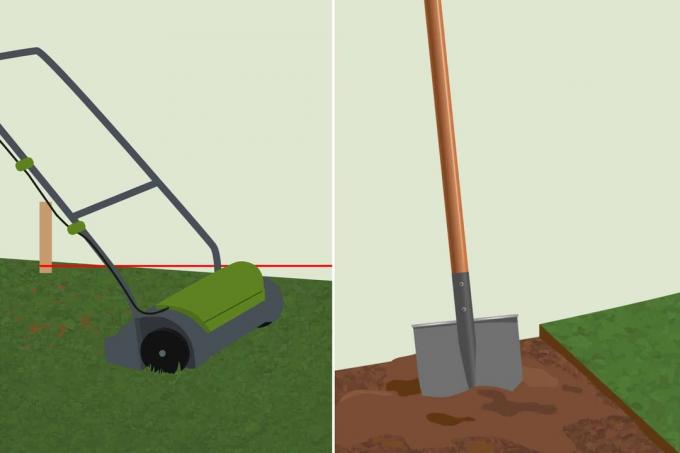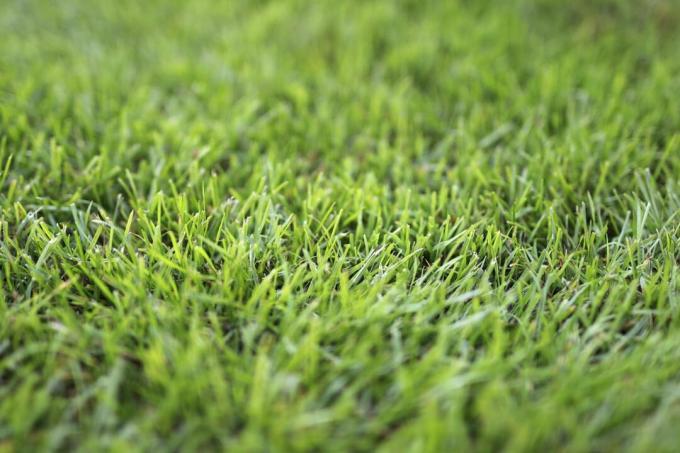

Table of contents
- Causes of fungi
- prevention
- Remove felt
- sand
- regulate humidity
- mowing
- fertilization
- remove roots
- garden lime
- cut out
- Remove foreign bodies
- fungicide
- Combined applications
If a fungus is found in the lawn, this is often just one of many. Therefore, before a stronger infestation occurs, immediate action should be taken. Prevention is also possible.
Causes of fungi
Fungal growth occurs primarily when the following criteria are met:
- lack of ventilation of the floor
- Felt on the lawn
- moss
- nutrient deficiency
- dead roots in the ground
- too high humidity up to waterlogging
- too little light
prevention
Fungal infestation can be prevented by checking the possible causes and adjusting the care of the lawn accordingly. Because well cared for and cared for grass plants are strong and can therefore assert themselves better against weeds and moss. On the other hand, the fungi are deprived of their breeding ground.
- adjusted fertilization
- if necessary, preparation of the soil
- pour or blast as needed
- regular mowing
Remove felt
It makes sense to remove thatch and moss in any case, because it allows the lawn to thrive better and aerates the soil. There are two options for this measure.

On the one hand, you can do it manually, using a rake and a rake. However, this is only suitable for very small lawns, as it is extremely physically demanding and takes some time. An alternative is a manual scarifier. However, this also requires considerable effort.
On the other hand, you can use an electric or petrol-powered scarifier. This is particularly advisable for larger lawns.
Tip:
A scarifier can be borrowed for use. For large lawns, however, investing in your own device can be worthwhile in the long term.
sand
If the soil tends to be compacted, working in quartz sand can help and loosen the soil. This improves ventilation and ensures better water drainage.
It is best to spread the sand with a spreader to achieve even distribution. Carry out the measure after mowing and scarifying so that the quartz can be worked well into the soil.
regulate humidity
One of the main requirements for the fungus is appropriate high humidity. This can be caused by persistently high precipitation as well as by too frequent watering. However, appropriate countermeasures can be taken. These are:
- water appropriately
- insert drainage
- loosen soil
mowing

Keeping the lawn short also ensures that moisture is regulated. Dew and raindrops can dry better. In addition, the grass plants branch out more, so that the risk of infestation with fungi and weeds is reduced.
fertilization
Adjusted fertilization keeps the grass plants strong and can therefore do more than just prevent fungus from spreading. For this, however, it is necessary that the nutrient supply is precisely coordinated and that the fertilizer is evenly distributed.
This includes a soil analysis. Take a sample of the soil and use a test kit or drop off the substrate at an appropriate test site. These include, among others:
- hardware stores
- nurseries
- garden center
Corresponding services are even offered online and in pet shops. A professional test is usually a bit more expensive than a corresponding set, but has corresponding advantages. It is more accurate and usually offers more variables to be examined.
remove roots
Mushrooms mainly grow in places where there are still tree roots that are rotten and slowly rotting away. The spread of the fungus ensures that woody roots decompose faster. If the remains of trees or bushes are removed in depth, the breeding ground is withdrawn.
garden lime
Lime changes the pH of the soil. This makes it possible to combat the fungal infestation in a targeted manner. As a rule, it is only necessary to treat the affected areas. However, if fungi appear all over the lawn, the garden lime can also be distributed evenly.
Tip:
Borrowing a spreader is very easy at the hardware store. However, since it is also suitable for spreading sand and fertilizer, the purchase is worthwhile in the long term.
cut out
A so-called witch ring is mushrooms that grow in a circular arrangement. The advantage of this is that the infestation is comparatively limited. This allows you to cut out the affected soil, bring in new soil and sow grass.

Be generous with the removal and start cutting out at least 20 centimeters from the mushrooms if possible. This also eliminates spores.
Remove foreign bodies
Twigs, branches and fallen fruit as well as garden furniture or swimming pools ensure that the grass does not receive enough sunlight. As the stalks decompose, the moisture beneath the items is increased and an ideal breeding ground for fungus is created.
Therefore, clear out the rubbish and rearrange furniture or decorations more often. As a result, the grass is not overly stressed and the spread of fungi can be effectively counteracted.
fungicide
Even with a heavy infestation, fungicides should be the last choice. To date, there are no approved fungicides for the targeted control of fungi on lawns. However, the agents for treating fungal infestations on plants may be used.
Combined applications
For safe prevention and removal, you should combine the means and measures with each other. This significantly increases the chance of a successful removal.
 garden editorial
garden editorial I write about everything that interests me in my garden.
Learn more about lawn care

Leveling out unevenness in the lawn: this is how it works
Unevenness in the lawn is annoying and poses a danger to gardeners, playing children and pets. There are a number of methods that can be used to level the lawn. We present them to you in our guide.

Leveling the lawn: how to smooth uneven surfaces
Dents and holes in the lawn are unsightly. We will show you step by step how to smooth uneven areas in the lawn again.

Algae in the garden | Lawn is slippery: what to do?
Algae love rainy days. Can the water seep badly into the ground, even better! The green, slippery mass is not only not a pretty sight, but also a danger for the lawn. Only those who act preventively and correctly in acute cases can avoid permanent damage.

Aerate the lawn | Before or after mowing?
Sun, water, fertilizer and air are necessary for the lawn to grow. If the lawn does not get enough air, it cannot grow properly. We clarify when the right time to ventilate the lawn is.

Mulching with lawn clippings: 13 things to consider
Keeping the lawn short is a must for many hobby gardeners. However, if the lawn mower does not have a mulching function so that the grass clippings can remain on the lawn, the question arises as to where to put the waste. Because the compost heap is not a good solution here.

How much soil do I need per m²: Apply lawn soil
If an area in the garden is to be converted into a lawn, then it makes sense to distribute the appropriate soil as a substrate. This raises the question of how much lawn substrate is required per m² of area. It does not matter whether turf or sowing is used afterwards.



